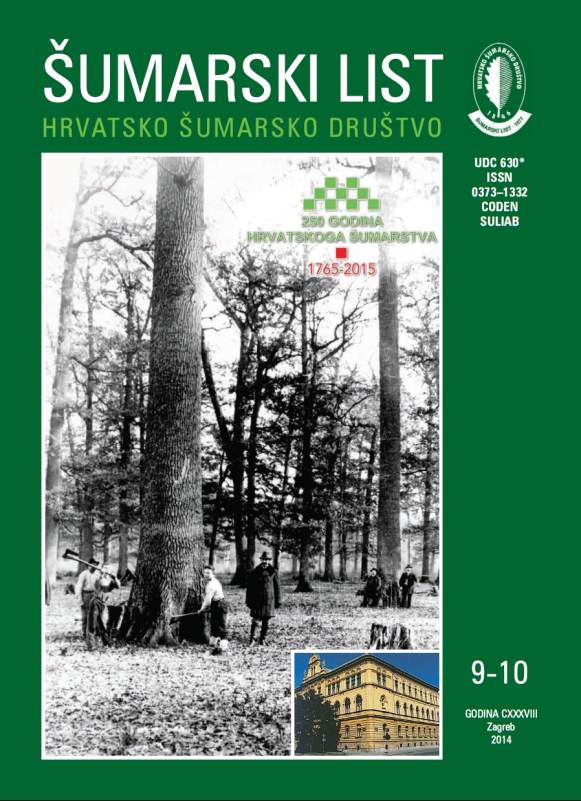
broj: 9-10/2014
pdf (10,9 MB) |
|
||||||||||||||
| RIJEČ UREDNIŠTVA | ||
| Uredništvo | ||
| AWAITING THE 250TH ANNIVERSARY OF ORGANIZED FORESTRY IN CROATIA pdf HR EN | 437 | |
| Man became keenly aware of the importance of forests for his life long ago: hence his determination to protect it against excessive felling, diseases and pests and regenerate it after cataclysms (fires, windbreaks and similar). Both in the world and in our country the treatment of forests was regulated several centuries ago. This refers particularly to our coastal region, where the need for timber and pastureland, as well as the occurrence of fires, winds and similar were felt most acutely. The Statutes of the towns regulating the management of forests and banning excessive harvesting and timber export include the island of Korčula (1245 and 1265), Dubrovnik (1272), Zadar (1305), Split (1312), Trogir (1322), the island of Krk (1388) and others. Austria founded a special forest administration in Istria in 1553, while Colbert’s Forest Ordinance of 1669 was applied to the Illyrian provinces as well. Yet, all these activities were unsynchronized and limited to local forested areas. Organized forestry took root in 1765 with the publication of a definitive forest order, written on the basis of a temporary forest order, which was prepared by Baron Beck for the forests of the Karlovac Generalate in 1764. Namely, after the Karlovac Peace Treaty of 1699, Austria expanded the Military Border area to Slavonia, and in 1746 it reorganized the Military Border by dividing it into 11 regiments (the regiments of Lika, Otočec, Ogulin, Slunj, 1st Banska, 2nd Banska, Brod, Gradiška, Križevci, Bjelovar and Petrovaradin). A military forestry service was established in these regiments, since almost 40% of the Military Border area was covered by forests composed of different tree species. The above mentioned definitive forest order contained 34 articles with detailed regulations on felling of forests, export and trade. Waldmeister Franzoni used it to write instructions for forest personnel. The military command stationed in Karlovac entrusted Franzoni with the surveillance of forests. That same year saw the establishment of first forest offices in Croatia: in Oštarije for the forests of the Lika regiments, in Krasno for the forests of the Otočec and a part of the Ogulin regiments, and Petrova gora for the forests of the Slunj and the remaining Ogulin regiments (the first forest offices were also established in Europe at the same time). In the course of 1764 and 1765, Major Pirker and his officers carried out field work for these three regiments. Work included the descriptions and maps, which were used to perform the first division of forests into districts, forestry offices and guarded forests. The maps were made at a scale 1 : 3888 of "fortification fathoms". The Royal forest supervisor Bogoslav Kosović used the data and the relevant maps contained in the War Archive from Vienna to write about this issue in the Forest Journal in 1914 and 1915. The article dealing with this topic was entitled "The first forestry specialist description and map of the forests on Velebit, Velika Kapela from the Dalmatian border to Mrkopalj and Ogulin". According to the Working Programme of the Croatian Forestry Association for the year 2015, the whole upcoming year will abound with the activities related to this important anniversary of Croatian forestry. In addition to the Croatian Forestry Association, this anniversary will also be marked by the competent Ministry, the company Croatian Forests Ltd, the Academy of Forest Sciences, the Faculty of Forestry of the University of Zagreb, the Croatian Forest Research Institute, the Croatian Chamber of Forestry and Wood Technology Engineers, the Croatian Union of Private Forest Owners’ Association and the Zagreb City Office for Agriculture and Forestry. This is an opportunity not to be missed for forests and forestry to "come out of the shadow". With this in view, we invite all forestry experts to contribute to the celebration of this important anniversary of Croatian forestry. In the end, due to the delayed publication of Forestry Journal 11–12/2014 out of objective reasons, we would like to take this opportunity to wish all the readers of our scientific-specialist and professional journal Merry Christmas and a Successful Year 2015. Editorial Board | ||
| IZVORNI ZNANSTVENI ČLANCI | ||
| Igor STANKIĆ, Jurij MARENČE, Dinko VUSIĆ, Željko ZEČIĆ, Zlatko BENKOVIĆ | UDK 630*537 (Fagus sylvatica L.) (001) | |
| STRUCTURE OF THE COMMON BEECH ABOVEGROUND TREE BIOMASS IN DIFFERENT STAND CONDITIONS pdf HR EN | 439 | |
| Dražen DEGMEČIĆ, Tihomir FLORIJANČIĆ | UDK 630*156 (Cervus elaphus, L.) (001) | |
| THE IMPACT OF CLIMATE AND HYDROLOGICAL FACTORS ON DEVELOPEMENT OF RED DEER (Cervus elaphus, L.) ANTLERS IN THE CROATIAN PART OF BARANJA DANUBE REGION pdf HR EN | 451 | |
| Goran JELIĆ, Vlado TOPIĆ, Lukrecija BUTORAC, Zoran ĐURĐEVIĆ, Anamarija JAZBEC, Milan ORŠANIĆ | UDK 630*232 (001) | |
| CONTAINER SIZE AND SOIL PREPARATION EFFECTS ON AFFORESTATION SUCCESS OF ONE YEAR OLD STONE PINE (Pinus pinea L.) SEEDLINGS IN CROATIAN MEDITERRANENAN AREA pdf HR EN | 463 | |
| PRETHODNO PRIOPĆENJE | ||
| Andrej VERLIČ, Nataša ĐURIĆ, Žiga KOKALJ, Aleš MARSETIČ, Primož SIMONČIČ, Krištof OŠTIR | UDK 228+614 | |
| TREE SPECIES CLASSIFICATION USING WORLDVIEW-2 SATELLITE IMAGES AND LASER SCANNING DATA IN A NATURAL URBAN FOREST pdf HR EN | 477 | |
| STRUČNI ČLANCI | ||
| Alojzije FRKOVIĆ | UDK 630*156 (Axis axis Erxleben 1977) | |
| INTRODUCTION OF THE AXIS DEER (Axis axis Erxleben 1977) TO THE CROATIAN LITTORAL IN 1953 pdf HR EN | 489 | |


